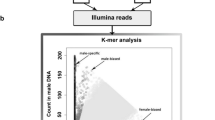Abstract
Two sex-linked random amplified polymorphic DNA (RAPD) markers identified from Actinidia chinensis were converted into sequence-characterised amplified regions (SCARs) for the large-scale screening of Actinidia breeding populations. Initial SCAR primers converted one RAPD (SmX) into a dominant marker, but the other (SmY), which was potentially more useful because of its linkage to the male determining ‘Y’ locus, failed to retain polymorphism. This difficulty was overcome by cloning and sequencing the alternate ‘allele’ from female plants, and then designing ‘allele’-specific primers that utilised nucleotide differences between the sexes. Using a quick squash-blot method of DNA extraction, the SCAR primers were tested in 120 A. chinensis plants to determine their gender. The system is now in use for large-scale screening of seedling populations in the Actinidia breeding programme. The sex-linked SCAR primers also functioned with plants from some other geographically separate accessions of A. chinensis and with plants in the closely related polyploid species A. deliciosa, but did not amplify a sex-linked band in more distantly related species of Actinidia.
Similar content being viewed by others
Author information
Authors and Affiliations
Additional information
Received: 27 December 1997 / Accepted: 5 March 1998
Rights and permissions
About this article
Cite this article
Gill, G., Harvey, C., Gardner, R. et al. Development of sex-linked PCR markers for gender identification in Actinidia. Theor Appl Genet 97, 439–445 (1998). https://doi.org/10.1007/s001220050914
Issue Date:
DOI: https://doi.org/10.1007/s001220050914




